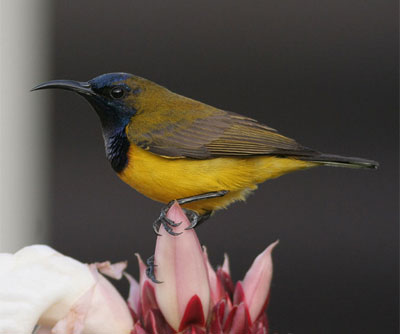
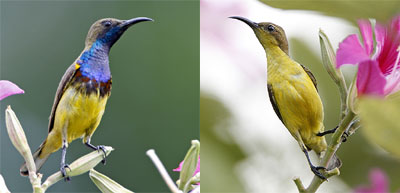
Male & female Olive-backed Sunbirds by Johan Svensson
Olive-backed Sunbird (Nectarinia jugularis) is one of those species that gets widely overlooked when birdwatching in Thailand; it is small, it is not particularly colourful (although the male is attractive enough) and it is commonest in habitats such as parks and gardens in which birdwatchers don’t spend much time. It is, however, quite remarkable for its adaptability, being found in virtually all habitats from mangroves, to forest edge: in fact, Olive-backed Sunbird is so ecologically tolerant that it is common even in plantations and cities, making it Thailand’s most abundant and widespread sunbird as this range map and accompanying text from A Field Guide to the Birds of Thailand indicate.
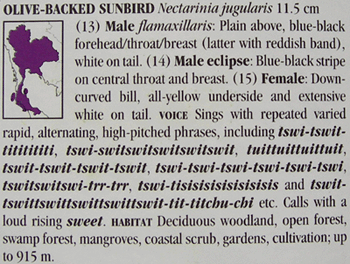
Olive-backed Sunbird in Bangkok’s Parks
For those intending a birding vacation in Thailand, Olive-backed Sunbird is almost certainly going to be seen, but it is by visiting a park that the best and most protracted views are likely to be obtained, where the species is very common: Lumphini Park, Suan Rot Fai and Suan Luang in Bangkok are all good places to study this interesting little bird.
Olive-backed Sunbird in Gardens
Olive-backed Sunbird takes nectar from flowers, as the scientific name suggests, as well as taking insects from leaves and spider’s webs and it is interesting to see that it pierces the base of the flower to “steal” the nectar rather than taking it from the flower’s aperture and effecting pollination. I quite often get the opportunity to watch this interesting behaviour as I have my breakfast in the morning when a pair of Olive-backed Sunbirds visit some flowering plants in our yard; sometimes it feels like we are having breakfast together. The flowers they favour in our yard are tiny, clustered affairs that don’t seem to have an opening and piercing the flower is the only way for the sunbirds to get in to the nectar.
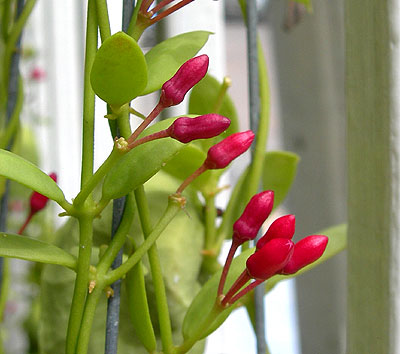
Sunbird-attracting Flowers by Nick Upton
In fact that Olive-backed Sunbirds make it into our tiny front yard at all is proof of how ecologically tolerant the species is: we have a small corner filled with pot plants in a street where the only vegetation is in the form of similar collections of pot plants in people’s yards and balconies. The area I live in is quite built up but there are a few areas of wasteland and fruit orchards remaining within a few hundred metres or so, however, this pair of sunbirds nests in a neighbour’s yard and seem to spend their whole time in this one street.

The small collection of plants in my yard that attracts sunbirds

The street I live in along with a pair of Olive-backed Sunbirds
The two above photos give some idea of how adaptable Olive-backed Sunbirds are in their habitat requirements: this is one of the few species that, happily, can live alongside humans in urban areas. Species such as this are important in connecting city dwellers with nature; this pair have certainly engaged my wife’s niece and nephew who wait for the sunbirds to appear on Saturday and Sunday mornings.
Observing & Photographing Olive-backed Sunbird Behaviour
Rather unusually for a small bird, Olive-backed Sunbird’s usual cluth size is just 2; one would assume that the energy expended in collecting enough nectar and insects for more than two young would push the parents beyond their limits of endurance. The nest is an untidy but complicated sac which hangs from vegetation and can frequently be found in gardens in Bangkok – the abundance of this species would certainly make it an interesting subject for armchair ornithologists to study: certainly photographers find it a good subject as these lovely photos by Peter Ericsson prove.
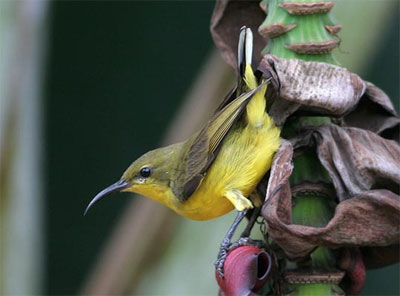
Female Olive-backed Sunbird by Peter Ericsson

Male Olive-backed Sunbird by Peter Ericsson
For more photos of Olive-backed Sunbird check out Johan Svensson’s beautiful collection of pictures of this species: Olive-backed Sunbird.
Those interested in learning much more about Olive-backed Sunbird and other sunbirds should get hold of a copy of Sunbirds: A Guide to the Sunbirds, Spiderhunters, Sugarbirds and Flowerpeckers of the World (Helm Identification Guides), it is available for less than £10 ($20).
Acknowledgements: Some of the information here comes from Phil Round’s book The Birds of the Bangkok Area.
birds, birding, thailand, nature


 June 14th, 2008
June 14th, 2008  Nick
Nick  Posted in
Posted in 










